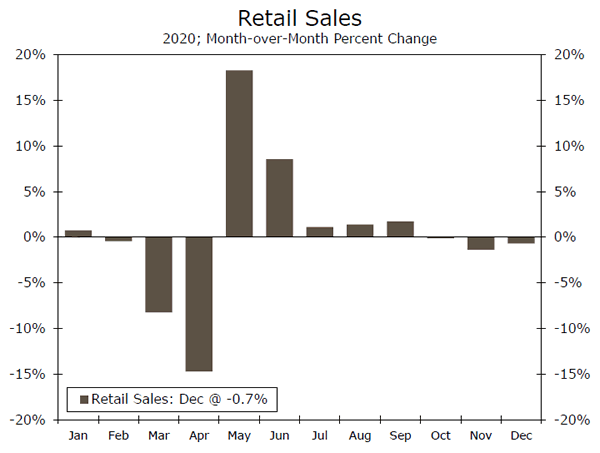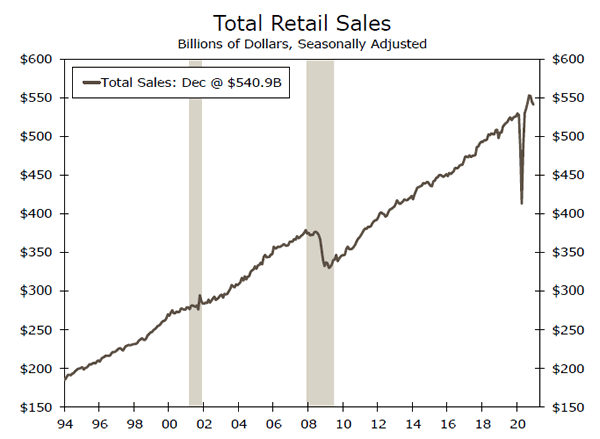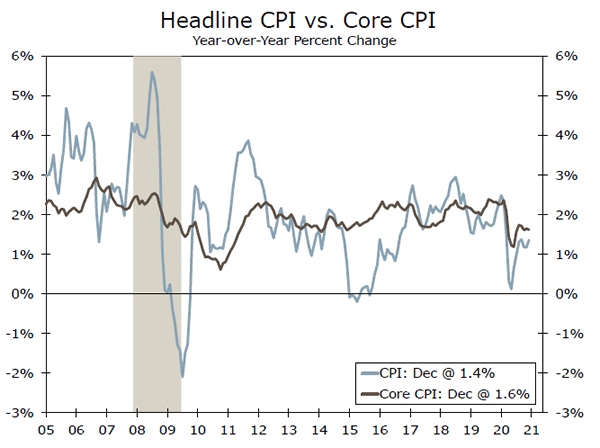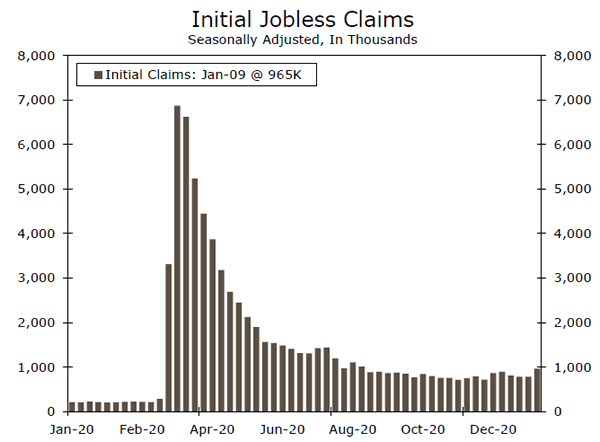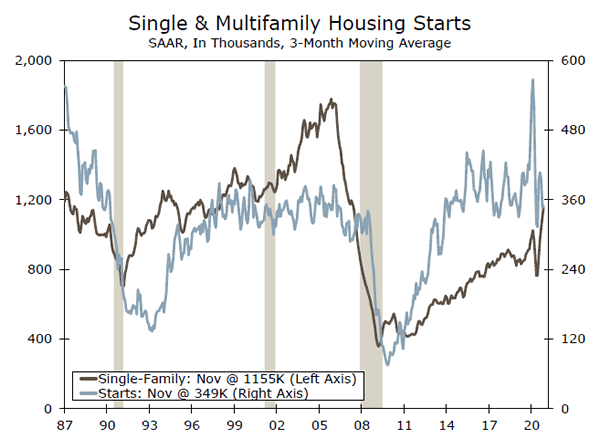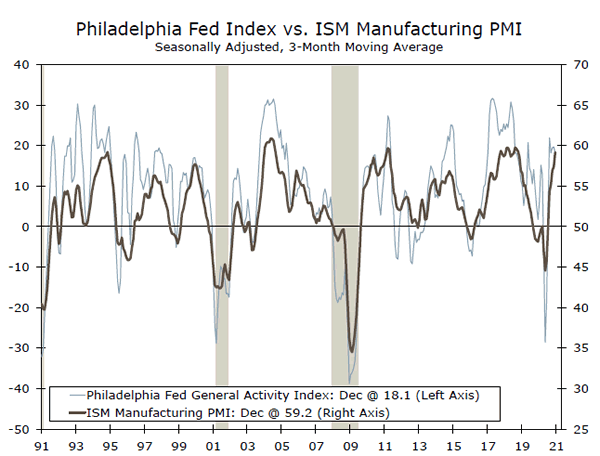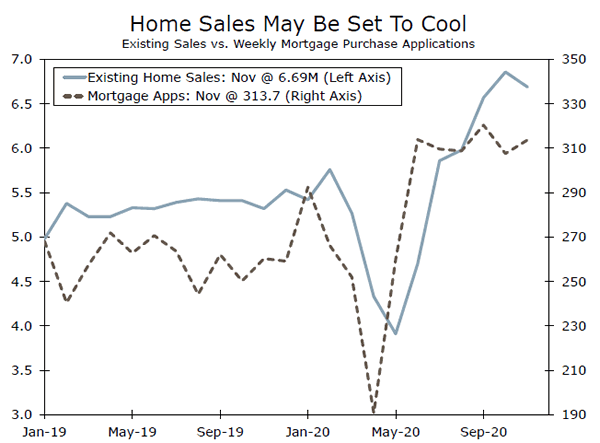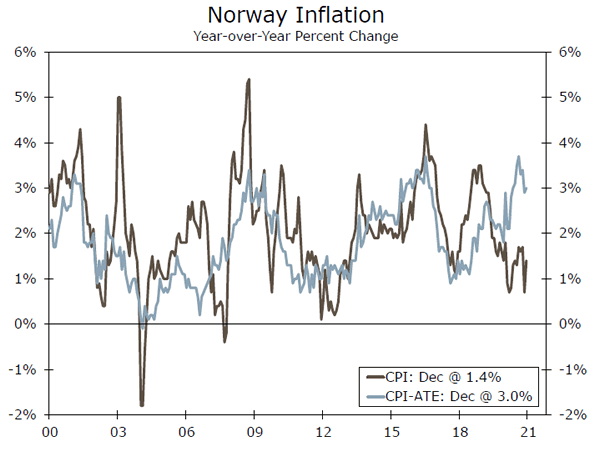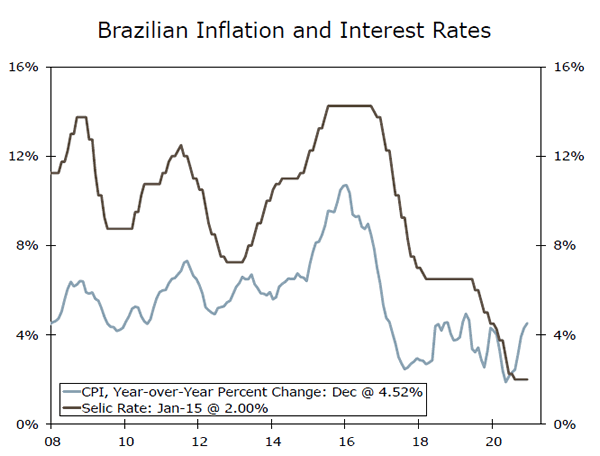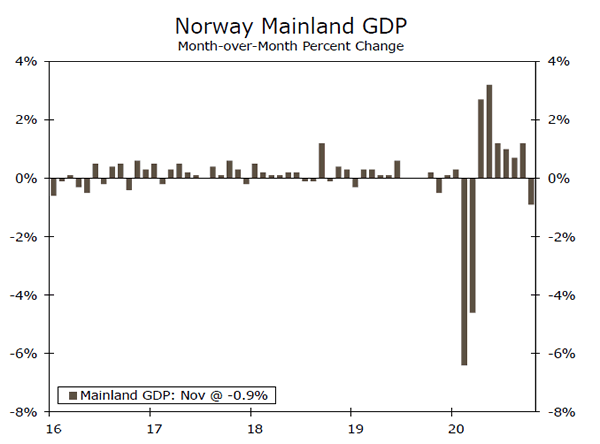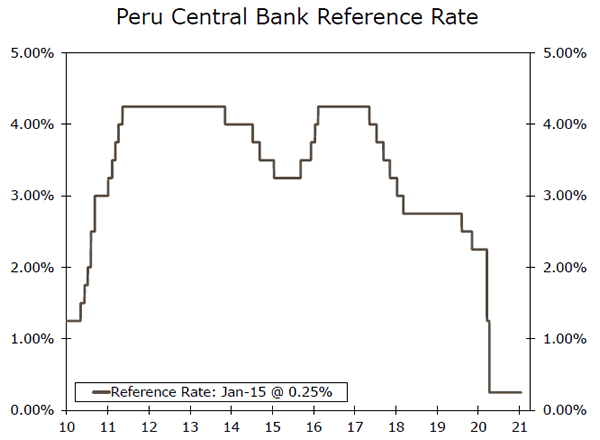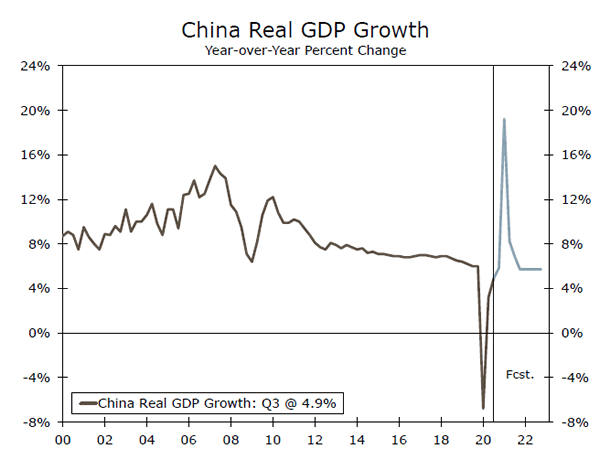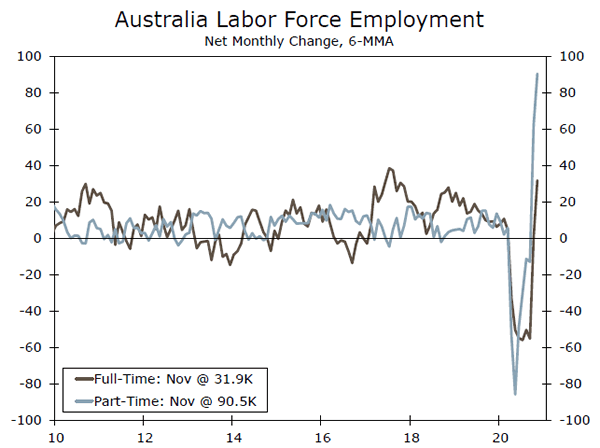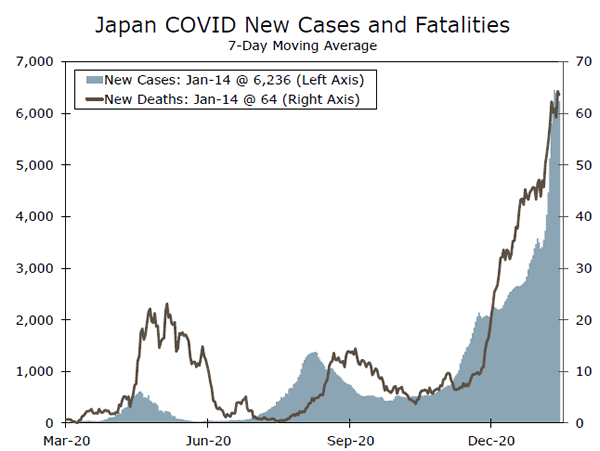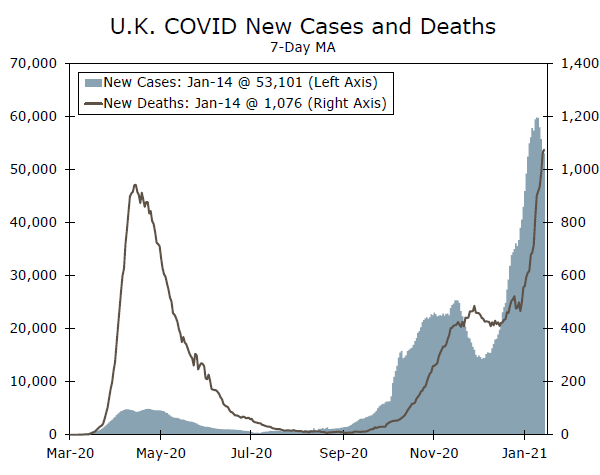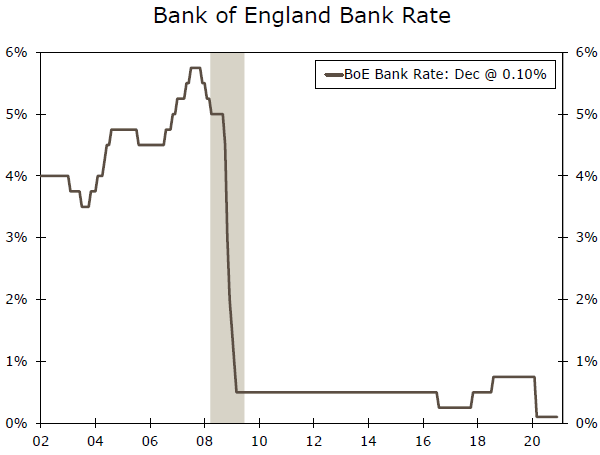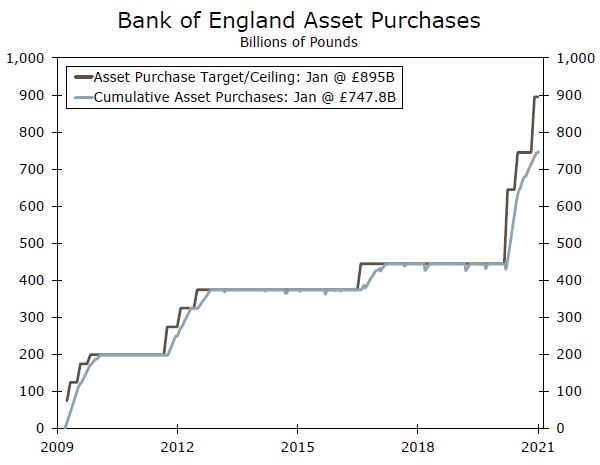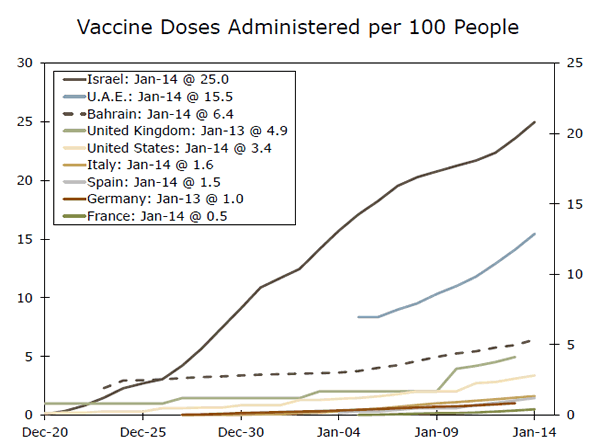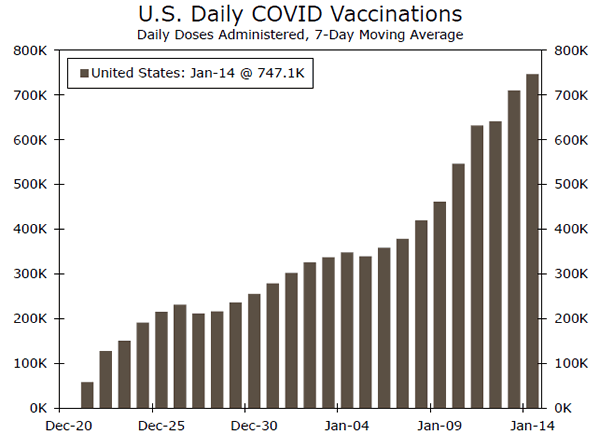U.S. Review
Consumers Pull Back as COVID Continues to Surge
- Retail sales fell 0.7% in December, the third straight monthly decline. Sales are still up 2.9% over the year, however.
- The CPI advanced 0.4% in December (1.4% over the year). Inflation remains tepid, with core prices up 0.1% in the month.
- Initial jobless claims jumped to 965K (week end Jan. 9).
- Several Fed officials pushed back on the idea of a shift in monetary policy anytime soon.
- Industrial production rose 1.6% in December.
- Small business optimism (NFIB) dropped to 95.9 in December. Consumer sentiment (U. Michigan) slipped to 79.2 in January.
Consumers Pull Back as COVID Continues to Surge
Attention this week was primarily focused on the state of the consumer amid the latest COVID spike. Retail sales dropped 0.7% during December, the third consecutive monthly decline. Total retail sales are still up 2.9% over the year, but surging COVID cases have led to diminished consumer sentiment and a pullback in consumer spending. On a brighter note, the pace of vaccine distribution looks to be ramping up (more on this in the Topic of the Week), and we expect consumer spending to improve as vaccines become more widely distributed.
We also anticipate a stronger pace of consumption will eventually lead to some modest inflationary pressures. But, inflation appears to be fairly subdued at present. During December, the Consumer Price Index (CPI) climbed 0.4%, an increase driven largely by rising food and gas prices. Core inflation rose at a more tepid 0.1% rate during the month, however. Inflation may temporarily pick up in the spring as COVID cases slow and consumer spending accelerates, but we do not foresee a sustained break-out higher.
In other words, inflation is likely to remain below the average inflation target which would prompt the Fed to tighten monetary policy. The topic of a sooner-than-anticipated rate hikes or asset purchase tapering has recently risen to the fore alongside vaccine deployment, additional fiscal relief and overall brighter prospects for economic growth. Several Fed officials pushed back on that notion this week. Governor Brainard emphasized that “the Fed is far from its goals” and Vice Chair Clarida said the FOMC would “not raise rates until inflation hit 2% for a year.” With regard to bond tapering, Fed Chair Powell commented that “now is not the time to talk about exit,” and that the Fed would “let the world know” before that process begins.
These sentiments are consistent with our view that the Fed will keep the federal funds rate at the zero lower bound for the foreseeable future. One of the reasons why the Fed is unlikely to shift gears anytime soon is that most recent wave of COVID appears to be weighing heavily on a still-fragile labor market. During the week ending January 9, initial jobless claims jumped to 965K from 784K the week prior, bringing initial claims to the highest level since August.
The resurgence of COVID is also bearing down hard on small businesses. Small business confidence fell 5.5 points to 95.9 in December. Firms reported weakening outlooks for business conditions and sales. Business owners are also likely concerned about tighter operating margins. While the share of small businesses raising prices dipped slightly in December, plans to raise prices rose one point. Producer prices do appear to be firming somewhat. Reported separately, the Producer Price Index (PPI) advanced 0.3% during December.
Meanwhile, the factory sector recovery continues. Industrial production increased 1.6% in December as manufacturing production rose 0.9%. Part of what has driven the recovery in manufacturing has been the upturn in consumer goods spending. Unfortunately, the slowdown in consumer spending is likely to lead to some moderation in manufacturing in the months ahead.
U.S. Outlook
Housing Starts • Thursday
Housing starts are expected to rise slightly in December, climbing 0.4% to a 1.553-million unit pace. While December is usually a slow month for housing starts, the weather this past December was milder than usual, which apparently allowed construction to proceed at a stronger pace than usual. Employment rose solidly in residential building and at residential specialty trade contractors last month, which would be consistent with at least a modest gain in housing starts.
There are some wild cards in the forecast, however. Soaring lumber prices, and shortages of many other key inputs, might cause some builders to hold off on starting new projects. If we were to see an upside surprise it would likely come from multifamily starts. Apartment construction also tends to swing wildly from month to month and has a tendency to spike at year end.
Previous: +1.2%, 1.547M Wells Fargo: +0.4%, 1.553M Consensus: +0.9% (Month-over-Month), 1.562M (SAAR)
Philadelphia Fed Outlook • Thursday
Given the light slate of economic reports in a holiday-shortened week, the Federal Reserve Bank of Philadelphia’s Business Outlook may carry a little more weight. The Philly Fed Survey is one of the earliest economic reports we receive, capturing activity from the second half of December and early part of January. Most other data still reflect the late November/early December period. The Philly Fed also closely reflects the trend in the ISM Manufacturing Survey, although more so over time than on a month-to-month basis.
The consensus is looking for nearly a three-point increase in January, from December’s downwardly revised level. After rebounding to 24.6 in October, the Philly Fed index has fallen for the past two months. The key components to watch are new orders, employment and the prices paid and prices received sub-indices. Oil prices rebounded during the period, which is a key input for the region’s large chemical industry.
Previous: 9.1 Consensus: 12.0
Existing Home Sales • Friday
Sales of existing homes are expected to fall 1.6% in December to a still exceptionally strong 6.58 million unit annual rate. Some leveling off in existing home sales has been widely expected. Mortgage applications for the purchase of a home leveled off some time ago and pending sales, which reflect purchase contracts for existing homes have fallen in recent months. Supply rather than demand appears to be the problem. Inventories of new homes have dropped to all-time lows as many homeowners remain reluctant to open up their current home to potential buyers.
Our forecast calls for a slightly smaller than consensus drop. With this year’s calendar and less holiday travel, we suspect more closings than usual were completed in December, which should offset some of the decline foretold by pending sales and mortgage applications but also pull forward some closings from January.
Previous: -2.5%, 6.69M Wells Fargo: -1.6%, 6.58M Consensus: -2.1% (Month-over-Month), 6.55M (SAAR)
Global Review
International Data Mixed Over the Week
- Brazilian inflation surprised to the upside in December, rising 4.5% year-over-year. Brazil’s inflation has been steadily increasing since May amid lower interest rates, additional fiscal spending and a weaker exchange rate.
- Norwegian mainland output fell less than expected in November, suggesting risks to our Q4 GDP growth forecast are tilted toward the upside. Meanwhile, Norway’s inflation recovered in line with consensus estimates in December.
- Elsewhere, Peru’s central bank opted to continue its expansionary policy stance, holding its reference rate at 0.25% and indicated it is ready to increase stimulus if needed.
Brazil Inflation Still on the Rise
Brazil’s inflation continued to rise in December, pushing the real interest rate deeper into negative territory. The December IPCA inflation rose 4.5% year-over-year, surprising to the upside, while underlying inflation also accelerated over the month. The underlying details indicated that food and beverage prices rose 14.1%, while household goods and housing also saw a rise in prices, increasing 6% and 5.25%, respectively. Brazil’s inflation has steadily increased since May amid lower interest rates, elevated fiscal spending and a weaker exchange rate. Although the central bank has begun to unwind the aggressive fiscal stimulus, we expect inflation to continue to rise. That said, without direct checks and other types of fiscal support, we look for subdued consumer spending in the first half of the year. As a result, we have revised our 2021 growth forecast lower, now looking for 3.9% year-overyear increase.
Norwegian Monthly GDP Points to Brighter Q4
Norway’s economic output fell less than expected in November, with mainland GDP declining 0.9% month-over-month. Tighter COVID restrictions contributed to some of the fall in activity. Among other social distancing measures, restaurants, bars and cafes were banned from serving alcohol, shopping centers limited the number of customers allowed inside and people were advised to stay at home. The decline was most notable in the services industry, which fell by 0.7% over the month. The largest decline was seen in accommodation & food service activities, while arts, entertainment and other service activities also saw a decline. Meanwhile, household consumption fell by 1.4% as a result of stricter containment measures. Overall, the smaller-than-expected drop in November GDP suggest risks to our Q4 Norwegian growth forecast are tilted toward the upside.
Also this week, we got the latest look at Norwegian inflation with the December CPI release. Headline inflation jumped 1.4% yearover- year due in part by higher electricity prices, while underlying CPI edged up 3.0%, just below consensus estimates of 3.1%.
Central Bank of Peru Maintains Expansionary Stance
At its monetary policy meeting this week, the Central Reserve Bank of Peru (BCRP) opted to continue its expansionary policy stance, holding its reference rate at 0.25%, as widely expected, and will continue to implement liquidity injection operations. In the accompanying statement, policymakers noted that inflation in 2021 is expected to hover around the lower limit of the central bank’s target range, while leading indicators for December continued to improve more than expected, although activity remains below the levels seen in late 2019. The BCRP reiterated that it would continue to maintain a strong expansionary monetary stance for as long as needed to combat the negative effects of the pandemic on inflation. The central bank also indicated that it is prepared to increase stimulus using a range of measures.
Global Outlook
China GDP • Monday
China continues to lead the global economic recovery and will likely be the only major economy to post positive growth for the full-year 2020. However, leading growth indicators, such as PMI surveys, have begun to moderate slightly. In December, the manufacturing PMI edged lower to 51.9, more than expected, while the non-manufacturing PMI fell to 55.7 as new orders continued to slide.
Meanwhile, COVID still presents a risk to the economy as another wave of infections spread into the Hebei province near Beijing, leading to stricter pandemic control measures. In the case that these outbreaks take a turn for the worse, we could see local economic activity slowing more than we currently anticipate. That said, we currently look for a 5.8% year-over-year gain in GDP in the fourth quarter, and look for a 9.4% increase for full-year 2021.
Previous: 4.9% Wells Fargo: 5.8% Consensus: 6.2% (Year-over-Year)
Australia Employment • Wednesday
Australia’s labor market surprised markets again as the economy continued to recover in November. Overall employment jumped by 90,000, with the unemployment rate falling to 6.8%. One of the key drivers of the strong recovery was Victoria’s job growth. Employment in Victoria increased 74,000, after an 82,000 increase the previous month. The underlying details of the national report were also solid as full time and part time employment added 84,200 and 5,800, respectively, while hours worked increased by 2.5%. Next week’s release of the December labor market report will provide the latest insight into how the Australian economy is recovering. In the Reserve Bank of Australia’s most recent monetary policy minutes, the central bank indicated that there has continued to be a significant amount of spare capacity in the labor market and the economy more generally. That said, we will be examining the underlying details for any further indication of spare capacity.
Previous: 90,000 Consensus: 50,000 (Monthly Change)
BoJ Policy Decision • Thursday
At its December monetary policy meeting, the Bank of Japan (BoJ) held its policy balance rate and 10-year JGB yield target at -0.10% and 0%, respectively. However, the central bank did opt to extend the duration of its emergency financial support, and indicated depending on the impact of COVID, that it could extend the program further if necessary. Over the past several months, new COVID cases have increased significantly across Japan. As a result, the Japanese government is set to expand the area under the COVID state of emergency beyond the Tokyo area.
Despite the recent uptick in infections across the country, we continue to expect the BoJ to maintain its policy interest rate at -0.10% at its meeting next week, as well as over the course of 2021 and into 2022. We also look for the target for 10-year government bond yields to remain at zero percent.
Previous: -0.10% Wells Fargo: -0.10% Consensus: -0.10% (Policy Balance Rate)
Point of View
Interest Rate Watch
Negative Rates in the U.K.?
The number of new COVID cases in the United Kingdom has spiked in recent weeks, prompting the government to impose new restrictions across the country. As we noted in our most recent Monthly Economic Outlook, we project that these restrictions will cause the U.K. economy to contract in both Q4-2020 and Q1-2021. Consequently, market participants have been trying to determine how the Monetary Policy Committee (MPC) of the Bank of England (BoE) may respond to the renewed downturn in the economy.
The MPC initially responded to the pandemic by slashing its main policy rate to only 0.10% in March (middle chart) and increasing the size of its asset purchase program by £200 billion. The committee subsequently increased its asset purchase target an additional £250 billion, raising it £100 billion in June and £150 billion in November (bottom chart).
Since COVID cases have spiked, there has been increasing speculation that the MPC may take its Bank Rate into negative territory. If it did so, the BoE would join the European Central Bank as well as central banks in Japan and Switzerland that have negative settings on their main policy rates. These expectations may have been heightened earlier this week when MPC member Silvana Tenreyro gave a speech that was sympathetic to the benefits of negative rates. However, BoE Governor Andrew Bailey subsequently said that there are “lots of issues” with taking the Bank Rate into negative territory. In short, the MPC does not seem to have a unified view at present about the desirability of going negative, and analytical work on the issue continues at the BoE.
In our view, the MPC likely will not opt to take its Bank Rate into negative territory in the foreseeable future. If the committee judges that more monetary accommodation is needed, it would first opt for another increase in its asset purchase program, in our view. That said, negative rates clearly have some advocates on the MPC, and we acknowledge that policymakers could eventually go negative if the U.K. economic outlook were to deteriorate even further.
Credit Market Insights
What Happens When Mortgage Forbearance Ends?
Moratoriums enacted under the CARES Act are set to expire at the end of January or February, depending on the lender. Although labor market conditions have deteriorated, we doubt that we will see a surge in foreclosures that will weigh heavily on the housing market when forbearance programs end. According to the Mortgage Bankers Association (MBA), the share of mortgage loans in forbearance subsided to 5.5% in the first week of 2021—a significant improvement from the 8.6% peak hit in early June. MBA has reported that many borrowers exiting forbearance either continued to make their payments or modified their mortgage terms.
Borrowers who remain in forbearance are more likely to be in distress, with fewer making any payments and exiting forbearance in recent weeks. As the pandemic continues to rage, the pace of improvement will likely moderate further. In view of the upcoming deadline, several lenders are offering options that will allow borrowers to tack missing payments onto the end of their loan term, rather than facing a balloon payment when the moratoriums end. The situation could change, as the incoming administration may find ways to extend homeowner relief programs. The timing and magnitude of such policy is too uncertain to call at the moment, however.
Topic of the Week
How to Vaccinate the World
Roughly 35 million vaccine doses have been administered across at least 49 countries, since the world embarked on its largest vaccine campaign to date, according to official data compiled by Our World in Data. Israel has been quickest out of the gate, vaccinating roughly 25% of its population, including over 70% of Israelis over 60 years old, with the first dose in less than a month. In Europe, the U.K. has administered over 3 million doses equating to almost 5% of its population, while countries on the continent have been a bit slower in their vaccine approval and rollout (top chart).
In the United States, over 11 million doses have been administered, according to the CDC, leaving the country first in absolute number and fifth on a per capita basis. While this is impressive given that we first learned of the virus a little over a year ago, the economic and health consequences of the winter COVID surge have made clear that a rapid vaccine rollout cannot come soon enough. At the current pace of vaccination, it would take more than seven months to vaccinate 50% of the population. Moreover, the doses that have been administered only constitute a fraction of the 31 million of the doses that have been distributed according to the CDC. While some of these doses are likely in transit or being reserved for individuals’ second shot, the variation in doses used among states suggests that the patchwork of public health policies that has defined the response to the pandemic thus far has carried over to the vaccine rollout.
Fortunately, the pace of vaccinations is clearly accelerating, as the eligibility criteria loosens and states ramp up mass-vaccination sites (bottom chart). With the promise of more vaccines in the pipeline and ample appetite for additional spending on vaccine rollout, we remain optimistic that the United States and countries around the world will be able to overcome the logistical hurdles of this historic undertaking.




